The prime culprits for polluting your aquarium water and placing a heavy burden on your biological filtration system are ammonia, nitrites, and nitrate, all of which are produced as a byproduct of decomposing fish waste, uneaten food, and general detritus.
Most of those nasties are found lurking deep down in the aquarium gravel, and that’s why you need an efficient aquarium siphon vacuum cleaner. An aquarium siphon vacuum is basically a super-effective fish tank gravel cleaner. But which is the best aquarium vacuum cleaner, and how do you use one?
Read this article for the definitive guide to vacuuming your fish tank substrate and to see our honest reviews of the best products on the market today.
Quick Comparisons Of The 5 Best Aquarium (Siphon) Vacuum Cleaners
| IMAGE | BRAND | DETAILS | |
|---|---|---|---|
 | Python No Spill Clean and Fill Aquarium Maintenance System |
| View Product |
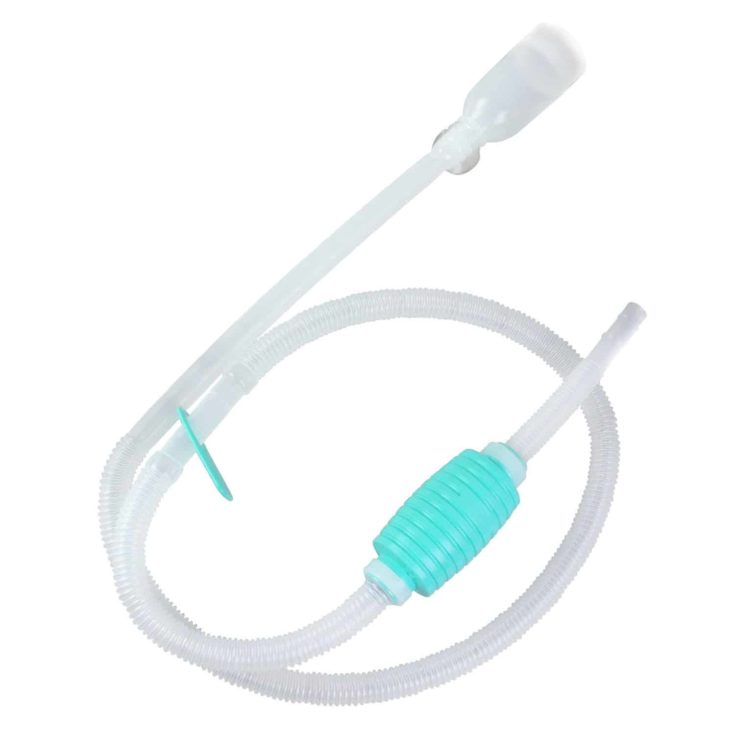 | TeraPump Aquarium Gravel & Sand BPA-Free Pump |
| View Product |
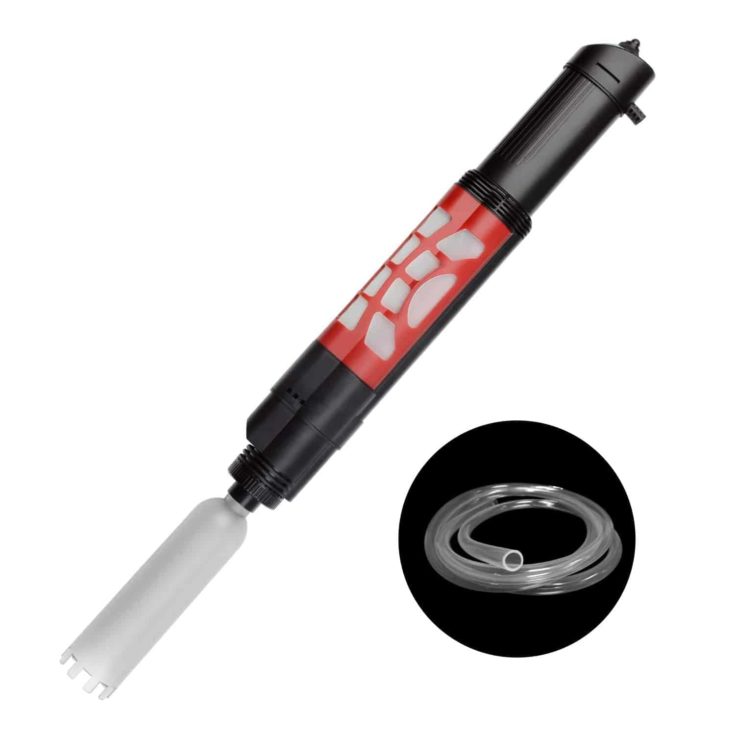 | NICREW Automatic Gravel Cleaner |
| View Product |
 | SunGrow Aquarium Vacuum Cleaner Pump Kit |
| View Product |
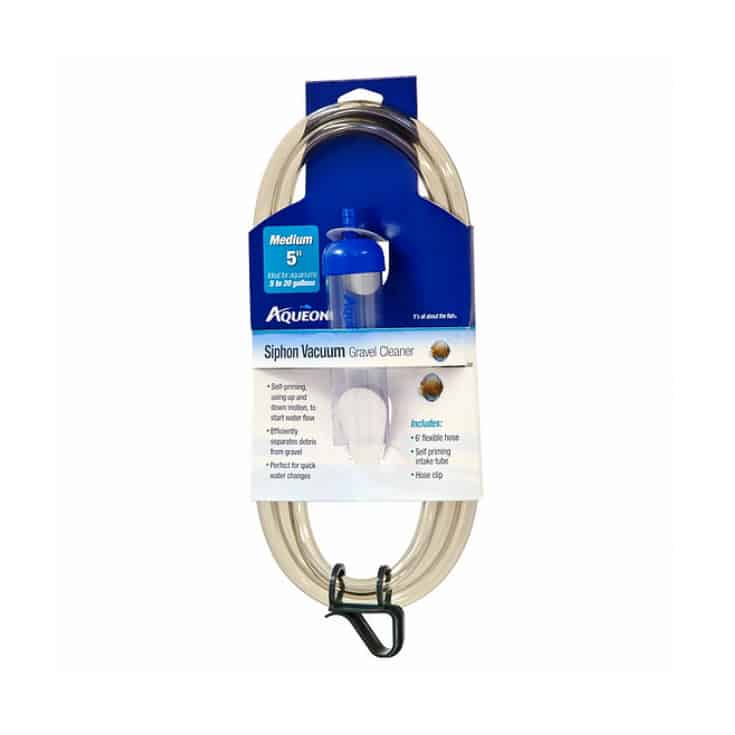 | Aqueon Siphon Vacuum Aquarium Gravel Cleaner |
| View Product |
What Is A Vacuum Cleaner For An Aquarium?
An aquarium gravel vacuum cleaner is basically a stiff plastic tube of around 2 inches in diameter, which is attached to a length of aquarium hose.
Some models have a valve system inside the vacuum cleaner element that controls the water flow and prevents very large pieces of muck from blocking the device. Others can be hooked up to a sink to help with siphoning, although most work with the assistance of gravity.
You can choose vacuums that have an air-filled bladder that you pump a few times to get the siphoning process started; otherwise, you need to do that manually.
How Does An Aquarium Vacuum Work?
A fish tank vacuum works simply by using gravity to siphon water and small items of particulate waste from the gravel in your fish tank, draining the waste into a bucket. The vacuum churns the gravel around inside a column of rotating water, loosening any debris that’s caught in the gravel and siphoning away the dirty, milky water.
How To Use An Aquarium Vacuum
Vacuuming your fish tank gravel is a simple process that you can incorporate easily into your weekly partial water change regimen.
You’ll need your aquarium vacuum cleaner kit and a bucket. Note that for the siphon to work properly, the bucket must be placed lower than the bottom of the fish tank.
Here’s how to do it:
- Place the rigid plastic part of the vacuum into your aquarium while the length of the aquarium hose hangs over the side of the tank, where it can drain into a bucket.
- To start the siphon, dip the vacuum head into the aquarium so that it fills with water.
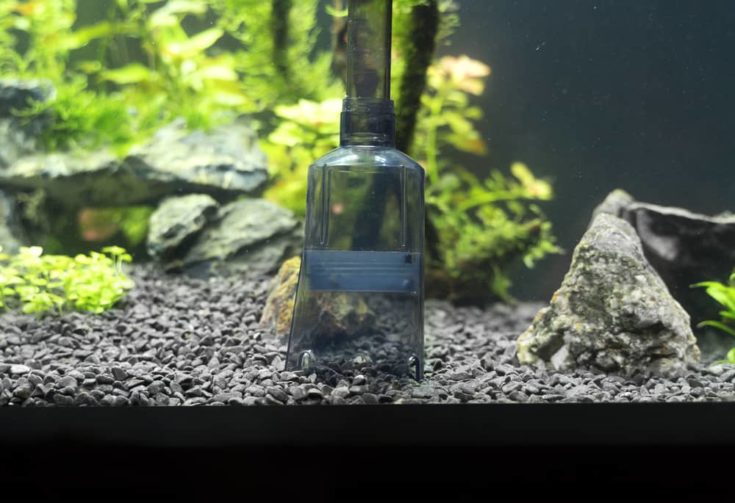
- When the vacuum head is full, remove it from the tank and let the water begin to drain down the hose and into a bucket.
- Just before the vacuum head is completely empty, push it back into the water. As you re-submerge the vacuum head, an air pocket forms in the plastic hose, pulling water through the vacuum and beginning the siphon process.
- Now, push the vacuum into the substrate and stir the gravel around a little. Some fragments of the substrate will be sucked into the device, together with lighter particulates, fish waste, and scraps of food.
- After a few seconds, lift the vacuum out of the gravel and allow the bits of heavy gravel to fall out of the plastic tube. The lighter waste continues on its journey through the hose and into the bucket.
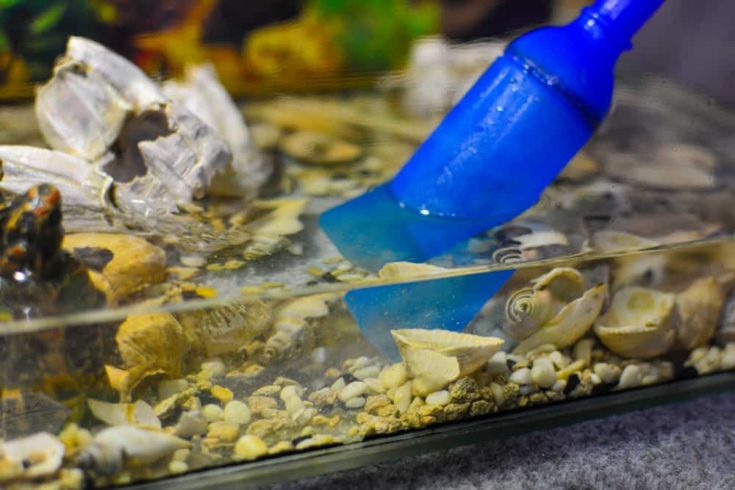
- Continue to vacuum your fish tank until you’ve removed 20% to 25% of the water. Pay particular attention to areas around and underneath rocks, plants, and internal filters, as these are places where waste tends to collect.
- When you’ve finished the job, rinse the vacuum thoroughly in warm water, and store it in a cool, dark place.
If you have deep gravel or you’ve created banks around the sides and back of your setup, make sure that you disturb the gravel right down to the glass walls or bottom of the tank so that no waste goes undetected.
Cleaning A Sand Substrate
If you have sand or a very fine gravel substrate in your tank, you can still use an aquarium vacuum, but the technique required is slightly different.

Because sand is very light, it can get sucked through the vacuum and right out of the tank, which is not what you want to happen. So, take care not to disturb the sand, get the siphon working, and then make the first pass over the bottom of the tank, hovering the vacuum right above the substrate so that you pick up any obvious waste that’s lying there.
Continue the process, carefully agitating the sand to disturb any waste that’s trapped there and keeping the vacuum above the substrate where it collects the muck that floats up.
What About Planted Tanks?
Heavily planted tanks can be tricky to vacuum, as you don’t want to risk uprooting any of your plants or damaging them. However, the job can be done if you choose a mini vacuum cleaner that can slip under low-growing plants and get among the stems of taller ones to remove debris without inflicting damage.
Recycle Dirty Aquarium Water

All that dirty aquarium water that you’ve drained into a bucket is packed with nitrates, and those waste products make an ideal fertilizer for plants. Rather than throwing the water down the drain, I use it to water my garden plants and pots, so I don’t need to buy expensive fertilizer, and I save water too!
What Are The Different Types Of Aquarium Vacuum Cleaners?
There are two types of aquarium vacuum cleaners, both of which have advantages and disadvantages.
Electric Gravel Cleaner
Electric aquarium vacuum cleaners don’t drain the water from the tank. Instead, water is pumped through the unit, catching any detritus in a filter and allowing the cleaned water to return back into the tank.
The main advantage of electric gravel cleaners is that you can give your tank a thorough deep clean without being limited by time and by the amount of water in the aquarium. Unfortunately, electric vacuums do have quite a few downsides.
| PROS | CONS |
|---|---|
|
|
Manual Siphon Gravel Cleaner
A manual siphon gravel vacuum consists of a hollow tube cleaner and a length of aquarium hose. Siphons are by far the most popular kind of aquarium vacuum system, being inexpensive and available in a range of sizes to suit all tanks.
The only real downside to manual tank vacuums is that you must also remove water from the aquarium in order to clean the substrate.
| PROS | CONS |
|---|---|
|
|
Why Vacuuming Your Tank Is So Important For Fish Health
The main reason to vacuum your aquarium substrate is to get rid of fish waste, plant debris, and uneaten food. If you leave that detritus in the tank, it will gradually decompose, releasing ammonia into the water, which is highly toxic to fish.
Your biological filtration system processes ammonia, keeping the environment clean and safe. However, if you remove particulates from the tank before they get the chance to break down, you will relieve the burden on your filters, keeping the tank cleaner and healthier for your fish.
Also, large pockets of debris that accumulate in the substrate can enable colonies of anaerobic bacteria to proliferate. Those bacteria feed on sulfur, which releases another toxic chemical called hydrogen sulfide into the water when disturbed. By regularly and thoroughly vacuuming your fish tank, you will prevent those “dead zones” from forming.
What About Healthy Bacteria?
Your biological filter system depends on healthy colonies of beneficial bacteria that live in your filter unit, on aquarium surfaces, and on the substrate. Luckily, aquarium vacuum cleaning doesn’t remove too many of those organisms as most will live in the filter media and on other surfaces that aren’t affected by vacuuming.
Water Changes
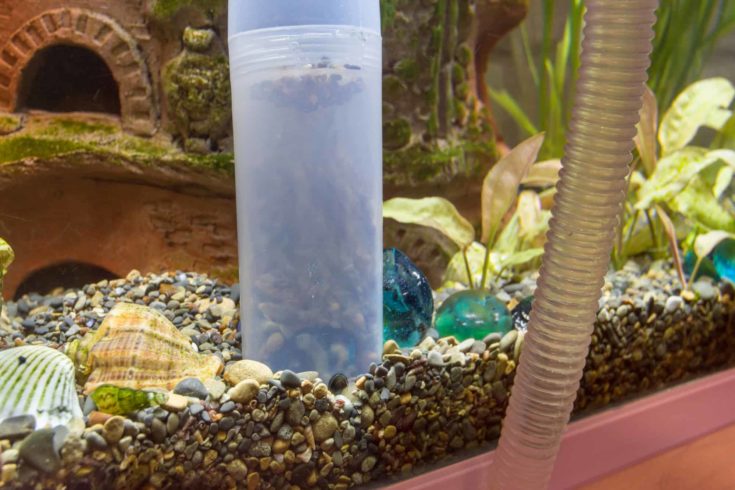
To keep the water in your aquarium clean and reduce the levels of nitrates and other harmful substances, you need to carry out partial water changes every week. Using an aquarium siphon vacuum cleaner kills two birds with one stone in that you can remove muck from the gravel and drain water from the tank at the same time.
I love my aquarium vacuum cleaner! I use a siphon-style cleaner, which enables me to keep the substrate in my dirty goldfishes’ tank super-clean, as well as draining away the dirty water, and all that’s achieved in double-quick time!
How Often Should You Vacuum The Gravel In The Aquarium?
It’s best to vacuum your fish tank every time to carry out a water change, so once a week or once every other week is ideal.
Remember to focus on areas around and underneath aquarium decorations, plants, and internal box filters. It’s amazing just how much waste and detritus collects in those places!
What To Look For When Buying An Aquarium Vacuum Cleaner

There are several considerations that you need to take into account when choosing an aquarium vacuum cleaner, and we’ll talk about those in this section of our guide.
Aquarium Inhabitants
The obvious danger when vacuuming your fish tank is that small fish, vulnerable fry, and invertebrates could easily get sucked right into the vacuum. So, if your setup contains small, vulnerable creatures, you choose a vacuum cleaner with a special filter attachment that prevents little fish and shrimps from accidentally being sucked up.
The main drawback to vacuum cleaners with filter attachments is that larger pieces of debris may not be removed from the tank, and they can block the filter. That can slow down the cleaning process as you’ll need to keep stopping to clean the filter.
Fish Tank Size

Fish tank size is probably the most important consideration when choosing an aquarium vacuum cleaner.
First of all, how deep is your fish tank? Ideally, you don’t want to put your arm in right up to your shoulder, so you need to choose a vacuum cleaner with a long tube or invest in a pair of aquarium gloves to keep your arms clean and dry while you work.
Also, the depth and amount of gravel that you have to clean will determine the size of the vacuum cleaner that you need. Generally, if you have a lot of substrates, you’ll need a fairly large vacuum that will generate sufficient suction power to get through it.
Aquarium vacuums come in three main sizes:
Standard/Large Size

Standard or large aquarium vacuums have a 2-inch diameter opening and are generally used in fish tanks of 20 gallons and over.
Small/Slim Size
Small or slim size aquarium vacuums have an opening of 1.5 inches in diameter and are suitable for use in fish tanks from 5 to 10 gallons.
Mini/Micro Size
Mini or micro-size fish tank cleaners have an opening of 1 inch in diameter and can be used in nano aquariums up to 5 gallons.
Combinations
It’s crucial that you buy the correct size aquarium gravel vacuum because a vacuum that’s too big will be too clumsy to move around your tank and will drain the water too quickly. However, if you do have a big setup, you might want to buy a mini vacuum too, as these smaller devices are extremely handy for cleaning around decorations, plants, and in the tank corners.

Many experienced aquarists have two or even three vacuum cleaners. A standard size siphon cleaner is ideal for carrying out a first-pass clean and is the quickest way of removing water from the tank during weekly water changes. However, if you have plants, lots of ornaments, or a hexagonal tank with multiple corners, you’ll need a mini-size vacuum.
Finally, if you have very dirty fish species in your setup, you’ll need an electric vacuum that cleans the substrate without removing any water from the tank so that you can carry out frequent cleaning between water changes.
Substrate Size
If you have a very fine or sandy substrate, look for a vacuum that has a filter fitted that prevents the substrate from being sucked through the vacuum and into the drain hose.
Personal Preference

The kind of aquarium gravel cleaner you choose depends on personal preference, too. You might prefer the idea of a cleaner that you can use for partial water changes, or you may lean toward an electric model that’s less labor-intensive.
Finally, do you want a vacuum that is self-priming, or are you happy to spend less money on a simple design that you need to start manually?
Top 5 Aquarium (Siphon) Vacuum Cleaner Reviews
Now that you know all about aquarium vacuum cleaners and how to use them let’s take a look at five of the best aquarium siphon vacuum cleaners that are available.
1. Python No Spill Clean and Fill Aquarium Maintenance System

- Aquariums of all sizes
- 25 to 100 feet
- All fish species
If you have a little extra cash to spare and you want an aquarium vacuum system that’s super-easy to use and very efficient, the Python No Spill Clean and Fill System is exactly what you need.
The vacuum cleaner comes in different sizes from 25 to 100 feet and four different options.
With the python system, you don’t need to worry about using buckets and carrying water to and from your aquarium while you’re cleaning it. You can safely use the system in planted tanks and with any species of fish and invertebrates.
The vacuum cleaner kit comes with a 10-inch, extendable gravel tube, hose connectors, a brass adapter, and a faucet pump.
| PROS | CONS |
|---|---|
|
|
2. TeraPump Aquarium Gravel & Sand BPA-Free Pump

- Aquariums of all sizes
- Works on sand and gravel
- All fish species
The TeraPump Aquarium Cleaner is effective for use with both gravel and sand and suits tanks containing any species of fish. The vacuum comes with two nozzles, a short one that’s designed for drainage and a longer one that you use to clean up fish waste, plant debris, and uneaten fish food. You can also use the device as a rock cleaner by passing it over decorations to pick up any debris that’s accumulated there.
The system removes detritus from the tank and drains water simultaneously without disturbing fish or plants. This super-efficient vacuum cleaner removes 1.5 gallons of water every minute, making it much more powerful than many other systems on the market.
| PROS | CONS |
|---|---|
|
|
3. NICREW Automatic Gravel Cleaner

- Medium to large tanks
- Works on gravel
- All fish species
The NICREW Automatic Gravel Cleaner system is an electric aquarium vacuum cleaner that’s suitable for use in medium to large tanks and also features a 2-in-1 sludge extractor. This device is perfect for you if you want a complete aquarium cleaning system that is also suitable for quick maintenance jobs.
The cleaner efficiently removes debris, uneaten food, and fish waste without disturbing the bottom layer of gravel, making this system great for use in tanks with undergravel filtration systems. You can use the system in tanks up to 28 inches in depth and in both freshwater and marine setups.
Those who are keen to keep the environment healthy will be pleased to know that the NICREW cleaner system is made using eco-friendly materials. Also, the device is mains-powered, so you don’t need to worry about battery life.
| PROS | CONS |
|---|---|
|
|
4. SunGrow Aquarium Vacuum Cleaner Pump Kit

- All tank sizes
- Works on gravel
- All fish species
Cleaning your fish tank can get messy, but that’s not a concern with the Sungrow Vacuum Cleaner pack!
The device incorporates a hand controller that’s very effective for getting rid of muck quickly and easily. You can use this vacuum cleaner with both freshwater and saltwater tanks too.
The short nozzle feature can be attached to the tank with a suction cup, leaving you with one hand free. To get the siphon started, simply squeeze the pump bulb five to seven times. The design of the unit helps to prevent gravel from passing into the cleaning hose.
| PROS | CONS |
|---|---|
|
|
5. Aqueon Siphon Vacuum Aquarium Gravel Cleaner

- Medium to large tank sizes
- Works on gravel
- Large fish and not invertebrates
The Aqueon Siphon Vacuum Aquarium Gravel Cleaner is a basic, no-frills that’s a great starter option for a beginner and for turtle tanks.
The vacuum needs to be started manually, but once you get it going, the suction it produces is quite strong, so it does drain the tank quite quickly, making this device unsuitable for very small tanks. Also, be aware that there’s no filter to prevent small fish and invertebrates from getting dragged into the device, so proceed with caution if you have those in your tank.
To prevent accidents and spills, a clip is included with the kit that you can use to secure the hose to your bucket.
| PROS | CONS |
|---|---|
|
|
Conclusion
We hope that you enjoyed our guide to aquarium siphon vacuum cleaners. As you can see, regularly vacuuming your tank’s substrate is essential to remove dirt and debris that will otherwise decompose, polluting the water and placing an additional burden on your filtration system.
Of the aquarium vacuum cleaners that we reviewed, we especially like the Python No Spill Clean and Fill system. Although this is not the cheapest cleaner that we look at, it certainly is the most versatile. There are four sizes of hose available from 25 to 100 feet; the system is safe for use in planted tanks and with any species of fish and invertebrates. Also, you get a 10-inch, extendable gravel tube, hose connectors, a brass adapter, and a faucet pump.
We think that this product represents great quality, excellent value for money, and is also extremely versatile. What’s not to like?!
